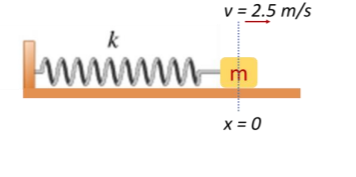shown in the figure below. The block is initially at the equilibrium point at x = 0 m where the spring is at its natural length. Then the block is set into a simple harmonic oscillation with an initial velocity 2.5 m/s at x = 0 cm towards right. The horizontal surface is frictionless. a) What is the period of block’s oscillation? b) Find the amplitude A of the oscillation, which is the farthest length spring is stretched to. c) Please represent block’s motion with the displacement vs. time function x(t) and draw the motion graph x(t) for at least one periodic cycle. Note, please mark the amplitude and period in the motion graph. Assume the clock starts from when the block is just released.
Simple harmonic motion
Simple harmonic motion is a type of periodic motion in which an object undergoes oscillatory motion. The restoring force exerted by the object exhibiting SHM is proportional to the displacement from the equilibrium position. The force is directed towards the mean position. We see many examples of SHM around us, common ones are the motion of a pendulum, spring and vibration of strings in musical instruments, and so on.
Simple Pendulum
A simple pendulum comprises a heavy mass (called bob) attached to one end of the weightless and flexible string.
Oscillation
In Physics, oscillation means a repetitive motion that happens in a variation with respect to time. There is usually a central value, where the object would be at rest. Additionally, there are two or more positions between which the repetitive motion takes place. In mathematics, oscillations can also be described as vibrations. The most common examples of oscillation that is seen in daily lives include the alternating current (AC) or the motion of a moving pendulum.
A block of mass m = 2 kg is attached a spring of force constant k = 500 N/m as shown in the figure below.
The block is initially at the equilibrium point at x = 0 m where the spring is at its natural length. Then the
block is set into a simple harmonic oscillation with an initial velocity 2.5 m/s at x = 0 cm towards right. The
horizontal surface is frictionless.
a) What is the period of block’s oscillation?
b) Find the amplitude A of the oscillation, which is the farthest length spring is stretched to.
c) Please represent block’s motion with the displacement vs. time function x(t) and draw the motion graph
x(t) for at least one periodic cycle. Note, please mark the amplitude and period in the motion graph.
Assume the clock starts from when the block is just released.
d) Please find out the block’s acceleration when it is at position x = 5cm.
e) On the motion graph you draw for part c), please mark with diamonds ♦ where the kinetic energy of the
block is totally transferred to the spring elastic potential; mark square ■ where the elastic potential of the
spring is totally transferred to the block as kinetic energy.

Trending now
This is a popular solution!
Step by step
Solved in 2 steps with 2 images







